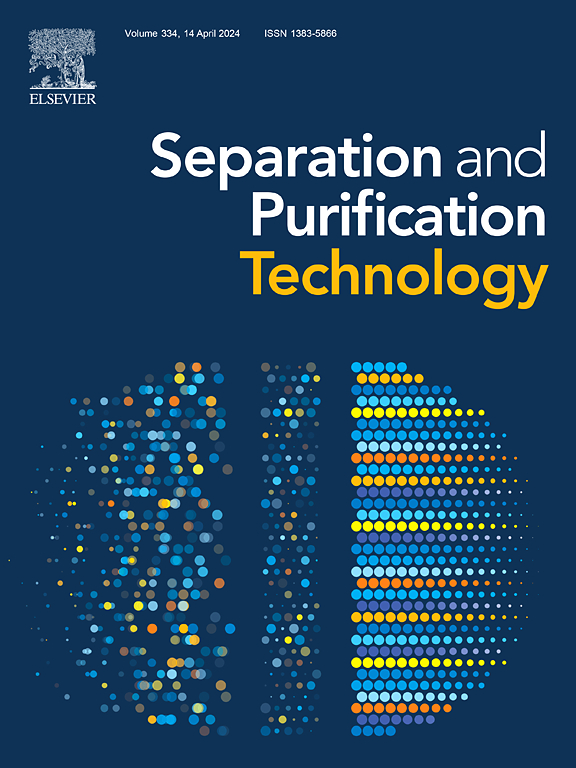Molecular insights into the enhanced water purification of algal-rich water by in-situ ozonation/manganese-doped ceramic membrane process
IF 8.1
1区 工程技术
Q1 ENGINEERING, CHEMICAL
引用次数: 0
Abstract
Harmful algal blooms significantly increase algae-derived organic matter (AOM) and algal toxins in surface waters, posing serious threats to aquatic ecosystems and public health. This study employed an integrated in-situ ozonation/manganese-doped catalytic ceramic membrane (Mn-CM) process to effectively purify algal-rich water. The effect of ozone dosage and the molecular-level mechanisms of organic contaminants removal were systematically investigated. Compared to sole ozonation or sole Mn-CM processes, the integrated process exhibited enhanced performance, achieving removal efficiencies of 22.56 % for dissolved organic carbon (DOC) and 92.05 % for microcystin-LR (MC-LR) at an ozone dosage of 1.0 mg/L. Results from Fourier-transform ion cyclotron resonance mass spectrometry and machine learning revealed the integrated process notably promoted the oxidative removal of unsaturated compounds with low O/C and high N/C ratios, mainly via oxygen addition, dealkylation and deamination reactions. MC-LR was more efficiently removed than DOC, predominantly due to its greater unsaturation, lower O/C and higher N/C ratios relative to raw AOM. Moreover, the integrated process facilitated oxidation of MC-LR into less toxic byproducts. These findings offer a theoretical basis for the future development and practical application of this integrated approach in real algal-rich water treatment.

原位臭氧氧化/掺杂锰陶瓷膜工艺强化富藻水净化的分子研究
有害藻华显著增加了地表水中的藻源有机物(AOM)和藻类毒素,对水生生态系统和公众健康构成严重威胁。本研究采用原位臭氧氧化/锰掺杂催化陶瓷膜(Mn-CM)一体化工艺对富藻水体进行了有效净化。系统地研究了臭氧用量对有机污染物去除的影响及分子水平的机理。与单一臭氧氧化或单一Mn-CM工艺相比,在臭氧用量为1.0 mg/L时,集成工艺对溶解有机碳(DOC)的去除率为22.56 %,对微囊藻毒素- lr (MC-LR)的去除率为92.05 %。傅里叶变换离子回旋共振质谱和机器学习的结果表明,集成过程显著促进了低O/C和高N/C的不饱和化合物的氧化去除,主要通过氧加成、脱烷基和脱氨反应进行。MC-LR比DOC更有效地被去除,主要是由于其相对于原始AOM具有更大的不饱和度,更低的O/C和更高的N/C比率。此外,集成过程促进了MC-LR氧化成毒性较小的副产物。这些研究结果为该综合方法在实际富藻水处理中的进一步发展和实际应用提供了理论基础。
本文章由计算机程序翻译,如有差异,请以英文原文为准。
求助全文
约1分钟内获得全文
求助全文
来源期刊

Separation and Purification Technology
工程技术-工程:化工
CiteScore
14.00
自引率
12.80%
发文量
2347
审稿时长
43 days
期刊介绍:
Separation and Purification Technology is a premier journal committed to sharing innovative methods for separation and purification in chemical and environmental engineering, encompassing both homogeneous solutions and heterogeneous mixtures. Our scope includes the separation and/or purification of liquids, vapors, and gases, as well as carbon capture and separation techniques. However, it's important to note that methods solely intended for analytical purposes are not within the scope of the journal. Additionally, disciplines such as soil science, polymer science, and metallurgy fall outside the purview of Separation and Purification Technology. Join us in advancing the field of separation and purification methods for sustainable solutions in chemical and environmental engineering.
 求助内容:
求助内容: 应助结果提醒方式:
应助结果提醒方式:


